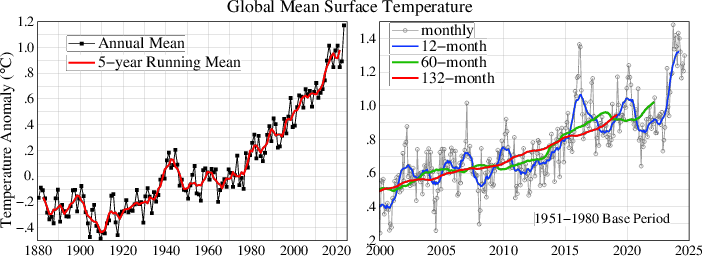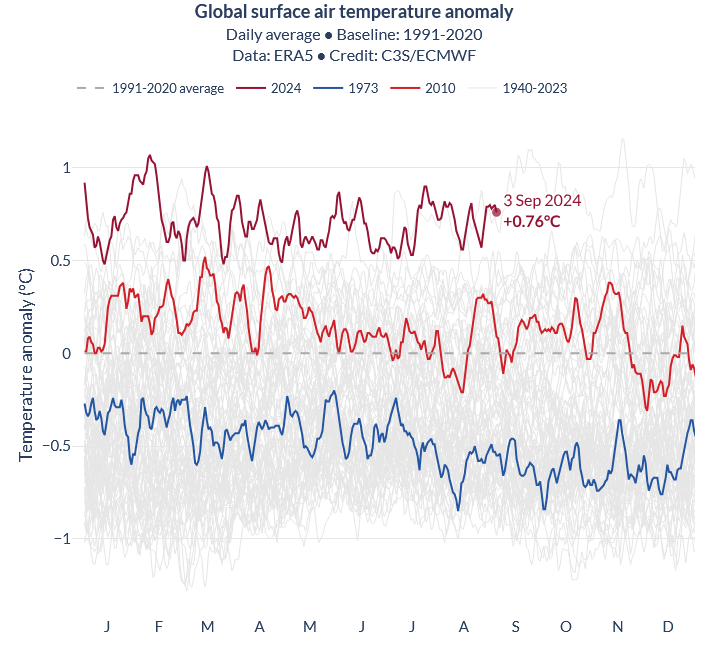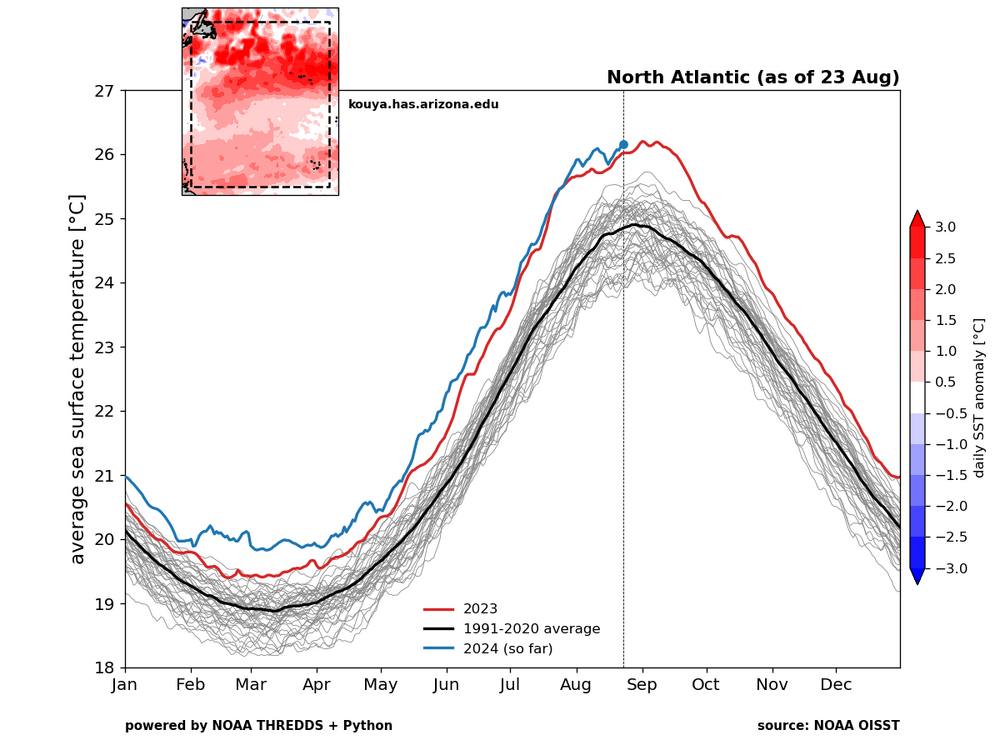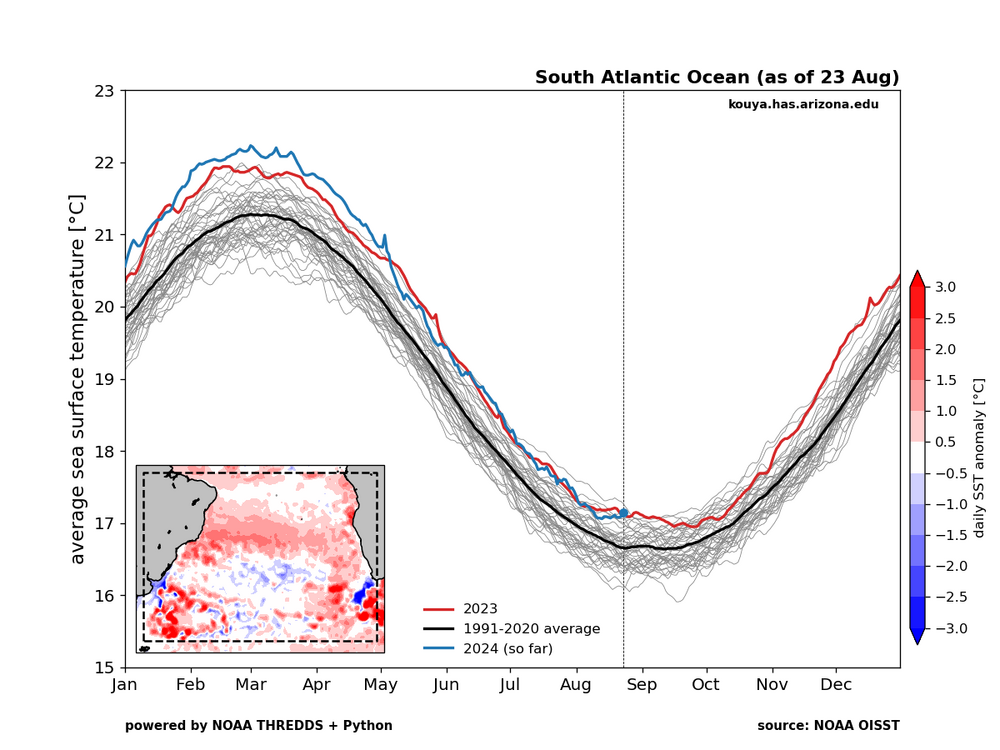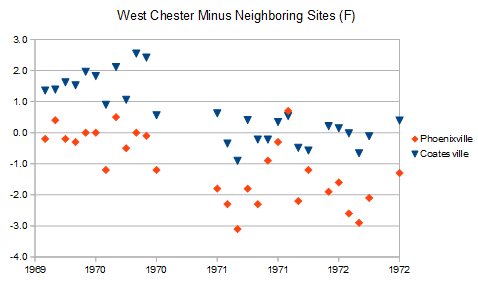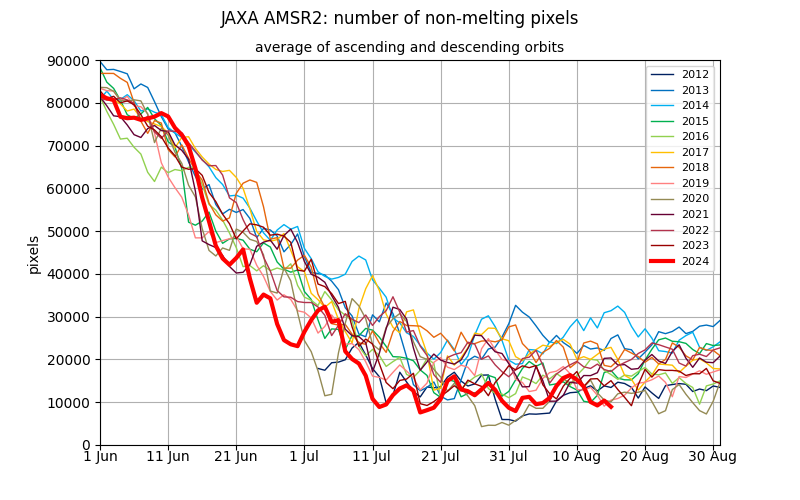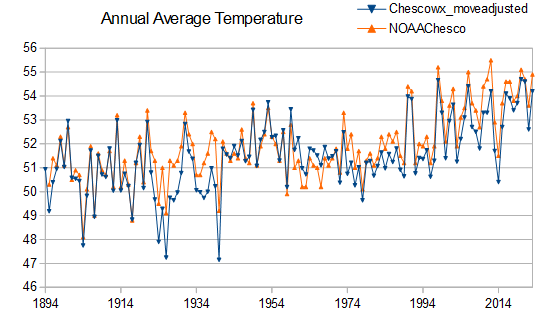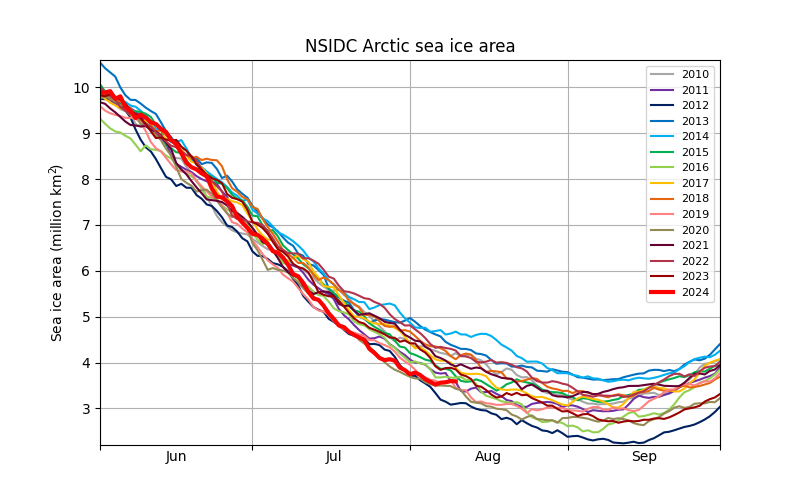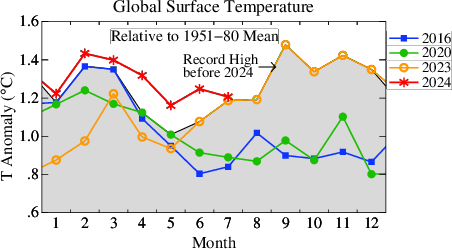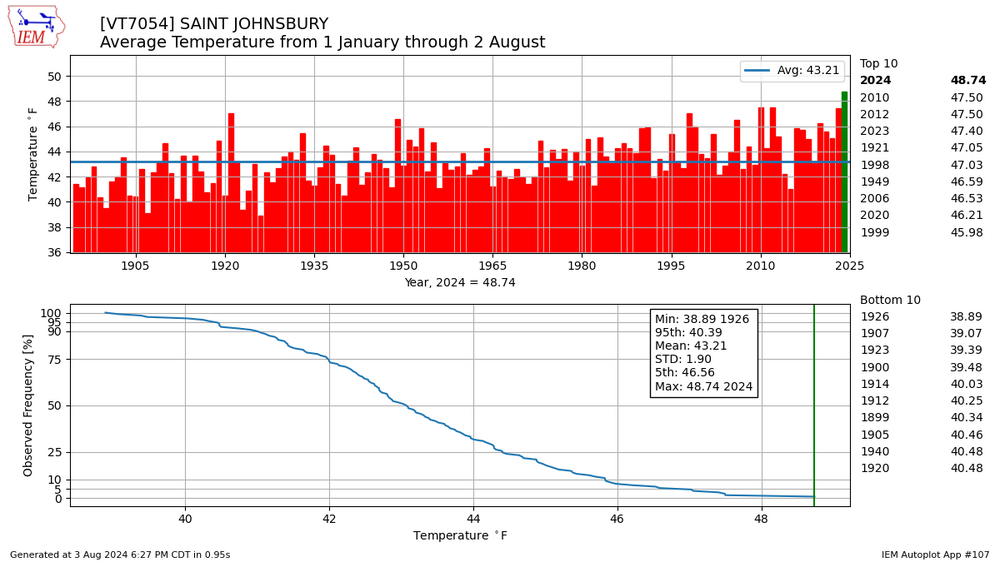
chubbs
Members-
Posts
4,059 -
Joined
-
Last visited
Content Type
Profiles
Blogs
Forums
American Weather
Media Demo
Store
Gallery
Everything posted by chubbs
-
August GISS came in at 1.30C, another monthly record. The Jan-Aug mean is 1.29 well above last years record of 1.17. A new record this year is almost guaranteed, probably somewhere around 1.24 allowing for some cooling in the last 4 months. The left-hand chart will probably need a new yaxis.
-
As usual there is no beef in Martz' criticism. Of course you get a different answer for raw vs adjusted. That's why the adustments are made; to correct known bias in the raw obs. Here's a better task for Martz or yourself: find a bias adjustment that is NOT justified by raw data collected at other sites. There are thousands of stations in the US, with multiple bias adjustments per station. If they are "arbitrary", surely you can find one that isn't justified. We didn't find any problems with bias adjustment in our Chester County deep dive. We focused on the larger, most important, bias adjustments; and didn't find any that weren't completely supported by the raw data. Quite the contrary, bias adjustments were needed to get an accurate estimate of Chesco's recent climate. Finally, one interesting finding in our Chester County deep dive: station moves had a much bigger biasing effect than TOBS. That probably happened elsewhere in the US as cars replaced horses and people moved out of towns to more remote sites.
-
Chester County PA - Analytical Battle of Actual vs. Altered Climate Data
chubbs replied to ChescoWx's topic in Climate Change
You can't understand Chester County's recent climate history if you don't account for station moves at Coatesville and West Chester. Easier to spot the cooling associated with moves from built-up towns---> less built-up sites, by separating before- and after-move portions of the station records. The moves are easily identified by the difference in the timing of move-related cooling: Coatesville cooled between 1945 and 1948; while, West Chester cooled in 1970. NOAA's scientific approach, using raw data from additional stations, confirms that the move-related cooling is spurious. -
You are going to be the last guy to realize its warming in Chester County. Warming is clear as can be in the raw Chester County data. If you are willing to look at it carefully.
-
August's ERA5 water precipitable water chart from Ben Noll. The chart is similar to previous months with moisture well-above pre-nino levels, continuing the relatively rapid rise in moisture over the past 10-15 years. The nino infuence should start to wane soon. We'll see if moisture drops back to pre-nino levels like most ninas; or, stays elevated like the 2015/16 nino.
-
-
This nino has produced August UAH6 anomalies, this year and last, that are much higher than the previous high of 0.38 in August 1998 and even higher relative to recent Augusts. With the notable exception of 1998, enso effects on UAH6 have generally been weak in August and other summer month; but, this nino has maintained high UAH6 values through 2 summers. The $64 question is where will be next August, when nino effects are completely washed out.
-
Surface melt balance anomaly for Arctic ice caps relative to 1980-2010. The grey shaded area is one standard deviation. Melt was slightly above average for Greenland and well above average for the remainder. Record losses occurred from Svalbard through Franz Joseph to the Russian High Islands, mainly in July and August, showing the warmth near the Atlantic sea ice margin. https://www.climato.uliege.be/cms/c_5855702/fr/climato-arctic
-
Blog from Gavin Schmidt on this paper. As one might expect, the headline is overblown. Paper contains useful paleo data, but doesn't move the ECS/ESS needle. https://www.realclimate.org/index.php/archives/2024/08/oh-my-oh-miocene/
-
Temperatures this year have been slow to fall, which almost guarantees another record. Year-to-date, ERA is running 0.24C warmer than 2023, and 0.22C warmer than 2016. The remainder of 2024 would have to average 0.41C on ERA to avoid a record, i.e. close to 2016. The rest of the year will be cooler than 2023, but not that cool. In a more likely scenario, 2024 continues to run 0.22C warmer that 2016, and breaks the record by 0.05C.
-
Relatively clear day today gives a good view of the "swiss cheese" pack this year, which is causing area to run unusually low relative to extent. This section is near the pole ( 88-89+N).
-
Report: Another Year of Record Heat for the Oceans
chubbs replied to donsutherland1's topic in Climate Change
-
Chester County PA - Analytical Battle of Actual vs. Altered Climate Data
chubbs replied to ChescoWx's topic in Climate Change
Using monthly raw data and comparing to nearby County sites it is very easy to spot when the West Chester station was shut down for several months and moved to a cooler site in 1970. The 1970 station move accounts for the bulk of the West Chester bias adjustment over the lifetime of the station. The older stations in Chester County were in much warmer locations than the stations we have today, older towns mainly, in the south and east portion of the county where people lived. Over the years stations moved to more rural sites and shifted north and west to better cover the whole county. If you assume that the Chesco monitoring network is the exactly the same today as it was 130 years ago you will be way off. -
Despite the pattern change, melt indicators have remained elevated through July and August. Picking up again in the past week, per the top chart.
-
Chester County PA - Analytical Battle of Actual vs. Altered Climate Data
chubbs replied to ChescoWx's topic in Climate Change
Below is Coatesville with a very rough adjustment for the town-->outside of town move, 2F phased in between 1946 and 48 (2 moves in that period). This single, crude, move adjustment removes most of the difference between NOAA and the raw data. The agreement isn't perfect, but you wouldn't expect it to be. Coatesville 1SW had multiple in town locations and Chescowx is 3 different sites (Coatesville 1SW, Coatesvelle 2W and East Nantmeal). Each move would have some impact on measured temperatures. There can be non-move station changes as well. With all the station moves at Coatesville and West Chester, you get a much better answer by accounting for station changes. -
-
GISS for July was 1.21 just edging 2023 for the 14'th straight monthly record. The last 2 months have been much warmer than 2016 and any pre-2023 year. The 2023/24 nino was fast to warm last year and is slow to cool down this year.
-
Sorry Paul! I posted the chart below previously. The move-related cooling is readily estimated from nearby stations. West Chester went from being like Phoenixville before the move in 1970, to being like Coatesville after, roughly 2F. The timing matches the station move exactly. Of course NOAA uses many more stations for a more robust estimate of the move's impact. Same story at Coatesville. A fact whether you accept or not.
-
Surprised that a heat island expert like yourself thinks that those town/city sites are representative. The Coatesville and West Chester station moves to more rural sites nearby caused roughly 2F of cooling. Accounting for the moves is why NOAA is spot on and you are way off.
-
And as usual, You've ducked my point. Do you think Phoenixville, the city of Coatesville, and the town of West Chester, are a good representation of Chester County?
-
The data lies if you don't use it properly. You have been putting out misinformation on our local climate for decades.
-
You are the guy who is altering our local climate. Phoenixville, the city of Coatesville, and the town of West Chester are a poor representation of Chester County. Much warmer than the county as a whole. No wonder you are so far off before the Coatesville and West Chester station moves.
-
This paper for fall AGU meeting indicates the earth's energy imbalance is the main reason this nino has been so warm. Note the rise in atmospheric heat content in 2024 due mainly to increasing water vapor content. https://agu.confex.com/agu/agu24/meetingapp.cgi/Paper/1553238
-
Amplified warming of North American cold extremes linked to human-induced changes in temperature variability "Here we show that cold extremes over North America have warmed substantially faster than the winter mean temperature since 1980. This amplified warming is linked to both decreasing variance and changes in higher moments of the temperature distributions. Climate model simulations with historical forcings robustly capture the observed trends in extremes and variability " "It is important to note that despite our results, winter cold extremes over North America will continue to occur. Winter tem- peratures over North America in the current climate have the highest variance57 and are some of the most strongly negatively skewed9,21 on Earth. This means that extreme deviations below the mean are expected to continue to occur in the future, even with rising global temperatures. However, because of the increasing mean temperatures, combined with the changes in temperature variability, cold extremes over North America will occur less frequently, and when they do occur, they will be less intense" https://www.nature.com/articles/s41467-024-49734-8.pdf
-

